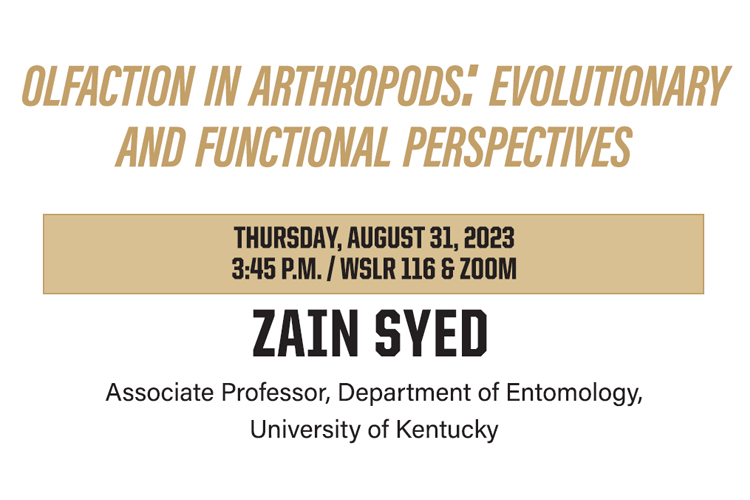
ENTM SEMINAR | Zain Syed: Olfaction in Arthropods: Evolutionary and Functional Perspectives
 Olfaction in insects plays a key role in locating food sources, mates, identifying suitable substrates for laying eggs, and avoiding harm. As insect navigate their complex chemical landscape defined by odorants originating from diverse origins, the olfactory system needs to resolve the landscape with a fine temporal and spatial resolution. To add to this complexity, insects - esp. females - undergo significant physiological changes during their lifetime that further define the salience of a given stimulus. An Asian fruit fly, Drosophila suzukii, offers an exciting model system to study these aspects. Adult female seeks out fresh fruits to lay eggs; both males and females of this fly are otherwise saprophytic, as are most other drosophilids. I will present a comprehensive analysis of the fruit odor profiles at varying ripening stages revealing significant qualitative and quantitative variations. Simultaneous olfactory physiological measurements from fly antennae to the odor constituents demonstrate accompanying peripheral modulations in gravid and non-gravid females that were further apparent in in the olfactory transcriptome. In addition to fruit flies, I will introduce our laboratory's latest work on signaling and reception in blood-feeding arthropods.
Olfaction in insects plays a key role in locating food sources, mates, identifying suitable substrates for laying eggs, and avoiding harm. As insect navigate their complex chemical landscape defined by odorants originating from diverse origins, the olfactory system needs to resolve the landscape with a fine temporal and spatial resolution. To add to this complexity, insects - esp. females - undergo significant physiological changes during their lifetime that further define the salience of a given stimulus. An Asian fruit fly, Drosophila suzukii, offers an exciting model system to study these aspects. Adult female seeks out fresh fruits to lay eggs; both males and females of this fly are otherwise saprophytic, as are most other drosophilids. I will present a comprehensive analysis of the fruit odor profiles at varying ripening stages revealing significant qualitative and quantitative variations. Simultaneous olfactory physiological measurements from fly antennae to the odor constituents demonstrate accompanying peripheral modulations in gravid and non-gravid females that were further apparent in in the olfactory transcriptome. In addition to fruit flies, I will introduce our laboratory's latest work on signaling and reception in blood-feeding arthropods.